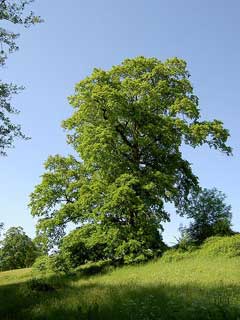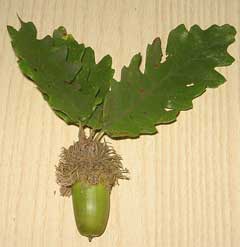 |
|
http://commons.wikimedia.org/wiki/User:Prazak |
 |
|
Translate this page:
Summary
Physical Characteristics

 Quercus_cerris is a deciduous Tree growing to 35 m (114ft) by 25 m (82ft) at a fast rate.
Quercus_cerris is a deciduous Tree growing to 35 m (114ft) by 25 m (82ft) at a fast rate.
See above for USDA hardiness. It is hardy to UK zone 6. It is in flower in May, and the seeds ripen in September. The species is monoecious (individual flowers are either male or female, but both sexes can be found on the same plant) and is pollinated by Wind.
Suitable for: medium (loamy) and heavy (clay) soils and can grow in heavy clay soil. Suitable pH: mildly acid, neutral and basic (mildly alkaline) soils and can grow in very alkaline soils.
It can grow in semi-shade (light woodland) or no shade. It prefers moist soil. The plant can tolerates strong winds but not maritime exposure.
UK Hardiness Map
US Hardiness Map
Synonyms
Q. lanuginosa.
Plant Habitats
Edible Uses
Seed - cooked. Up to 2.5cm long. It can be dried, ground into a powder and used as a thickening in stews etc or mixed with cereals for making bread[183]. The seed contains bitter tannins, these can be leached out by thoroughly washing the seed in running water though many minerals will also be lost. Either the whole seed can be used or the seed can be dried and ground it into a powder. It can take several days or even weeks to properly leach whole seeds, one method was to wrap them in a cloth bag and place them in a stream. Leaching the powder is quicker. A simple taste test can tell when the tannin has been leached. The traditional method of preparing the seed was to bury it in boggy ground overwinter. The germinating seed was dug up in the spring when it would have lost most of its astringency. The roasted seed is a coffee substitute. A sweet fluid exudes from insect damage on the stems and solidifies[2, 61, 105, 177]. This is edible and is sold as a manna in local markets in Iran[46]. It can be boiled down into a syrup and used for sweetening food[183].
References More on Edible Uses
Medicinal Uses
Plants For A Future can not take any responsibility for any adverse effects from the use of plants. Always seek advice from a professional before using a plant medicinally.
Any galls produced on the tree are strongly astringent and can be used in the treatment of haemorrhages, chronic diarrhoea, dysentery etc[4].
References More on Medicinal Uses
The Bookshop: Edible Plant Books
Our Latest books on Perennial Plants For Food Forests and Permaculture Gardens in paperback or digital formats.

Edible Tropical Plants
Food Forest Plants for Hotter Conditions: 250+ Plants For Tropical Food Forests & Permaculture Gardens.
More

Edible Temperate Plants
Plants for Your Food Forest: 500 Plants for Temperate Food Forests & Permaculture Gardens.
More

More Books
PFAF have eight books available in paperback and digital formats. Browse the shop for more information.
Shop Now
Other Uses
The seed cups are used as buttons[95]. A mulch of the leaves repels slugs, grubs etc, though fresh leaves should not be used as these can inhibit the growth of young plants[20]. Oak galls are excrescences that are sometimes produced in great numbers on the tree and are caused by the activity of the larvae of different insects. The insects live inside these galls, obtaining their nutrient therein. When the insect pupates and leaves, the gall can be used as a rich source of tannin, that can also be used as a dyestuff[4]. The leaves, bark and wood are used commercially as a source of tannins[223]. Wood. It is valued by wheelwrights, turners and cabinet makers[4]. Of little value[1, 11]. It does not weather well[100].
Special Uses
References More on Other Uses
Cultivation details
Prefers a good deep fertile loam which can be on the stiff side[1, 11]. Grows well on chalk[98], even when the soil is shallow[188]. Young plants tolerate reasonable levels of side shade[200]. Tolerates moderate exposure, surviving well but being somewhat stunted[200]. Grows well near the coast[98]. Intolerant of root disturbance, trees should be planted in their permanent positions whilst young[11]. A very ornamental tree[1], it grows very well in Britain and is the fastest growing of the oaks in cultivation in this country[1]. The seed ripens in its second year[200]. Trees transplant badly unless they are moved regularly[11]. Hybridizes freely with other members of the genus[200]. This species is notably resistant to honey fungus[88, 200].
References Carbon Farming Information and Carbon Sequestration Information
Temperature Converter
Type a value in the Celsius field to convert the value to Fahrenheit:
Fahrenheit:
The PFAF Bookshop
Plants For A Future have a number of books available in paperback and digital form. Book titles include Edible Plants, Edible Perennials, Edible Trees,Edible Shrubs, Woodland Gardening, and Temperate Food Forest Plants. Our new book is Food Forest Plants For Hotter Conditions (Tropical and Sub-Tropical).
Shop Now
Plant Propagation
Seed - it quickly loses viability if it is allowed to dry out. It can be stored moist and cool overwinter but is best sown as soon as it is ripe in an outdoor seed bed, though it must be protected from mice, squirrels etc. Small quantities of seed can be sown in deep pots in a cold frame. Plants produce a deep taproot and need to be planted out into their permanent positions as soon as possible, in fact seed sown in situ will produce the best trees[11]. Trees should not be left in a nursery bed for more than 2 growing seasons without being moved or they will transplant very badly.
Other Names
If available other names are mentioned here
Native Range
TEMPERATE ASIA: Lebanon, Syria, Turkey EUROPE: Austria, Switzerland (south), Czech Republic (south), Hungary, Slovakia, Ukraine (west), Albania, Bulgaria, Bosnia and Herzegovina, Greece, Croatia, Italy (incl. Sicily), North Macedonia, Montenegro, Romania, Serbia, Slovenia, France (southeast)
Weed Potential
Right plant wrong place. We are currently updating this section.
Please note that a plant may be invasive in one area but may not in your area so it’s worth checking.
Conservation Status
IUCN Red List of Threatened Plants Status :

Growth: S = slow M = medium F = fast. Soil: L = light (sandy) M = medium H = heavy (clay). pH: A = acid N = neutral B = basic (alkaline). Shade: F = full shade S = semi-shade N = no shade. Moisture: D = dry M = Moist We = wet Wa = water.
Expert comment
Author
L.
Botanical References
1117200
Links / References
For a list of references used on this page please go here
Readers comment
| Add a comment |
|
If you have important information about this plant that may help other users please add a comment or link below. Only comments or links that are felt to be directly relevant to a plant will be included. If you think a comment/link or information contained on this page is inaccurate or misleading we would welcome your feedback at [email protected]. If you have questions about a plant please use the Forum on this website as we do not have the resources to answer questions ourselves.
* Please note: the comments by website users are not necessarily those held by PFAF and may give misleading or inaccurate information.
To leave a comment please Register or login here All comments need to be approved so will not appear immediately.
|
|